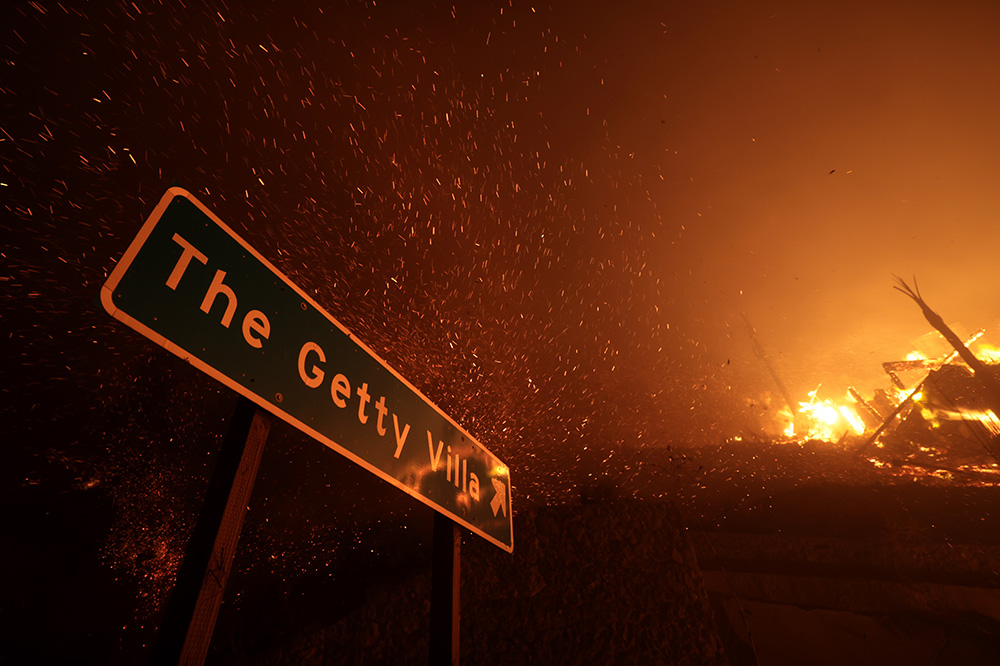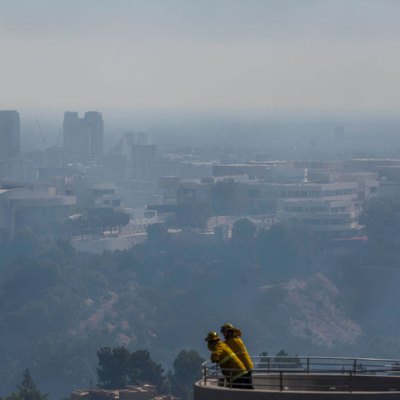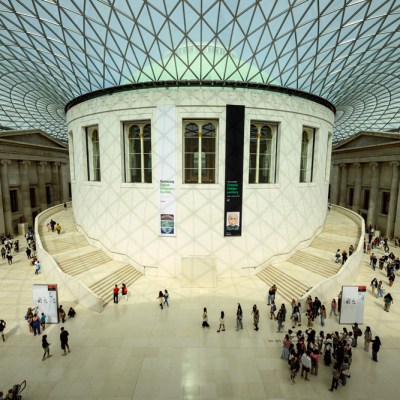Southern California is experiencing the most devastating wildfires in its history – and the fires are still burning. A combination of winds of between 50–80mph and extremely dry air have contributed to the unprecedented outbreaks. As of Friday 10 January, the fire in the Pacific Palisades area, west of Los Angeles, is thought to cover some 21,000 acres, with firefighters considering only eight per cent of it contained, reports the New York Times. The Palisades Fire reached the grounds of the Getty Villa on Tuesday 8 and, at time of writing on Sunday 12, the Getty Center in Brentwood, a western suburb of Los Angeles, also stands in an evacuation zone. The J. Paul Getty Museum’s fire-prevention strategies are regarded as among the best in the world and its CEO and President Katherine E. Fleming issued an updated statement on Saturday saying that the Center’s ‘galleries are safe and protected’ and that, ‘Aside from a few hot spots, the Villa remains stable.’ Historic landmarks that have been destroyed in the fires include the 1920s ranch house of the cowboy and comedian Will Rogers and the Keeler House designed by Ray Kappe, a founder of Sci-Arc. The Los Angeles Times is keeping a list of architecturally significant houses that have been destroyed here. Thousands of buildings have been lost all across the region, and artists such as Paul McCarthy and Diana Thater are among the many residents who have lost their homes and studios or archives. At least 11 eleven people are known to have died so far. Despite a slowing down in the spread of the fires on Saturday, the winds are expected to pick up on Monday, contributing to the renewed force of the blazes. Updated 12 Jan at 22.15 (GMT).
On Wednesday, the German federal government approved the setting up of an arbitration tribunal to rule on disputes about Nazi-looted art in the country’s institution, reports the New York Times. The new system, first proposed in March 2024, replaces an advisory panel, which could operate only with the consent of claimants and museums (sometimes lacking in the case of the latter), and made 23 recommendations in the course of its 20-year existence. The decisions of the Arbitration Court for Nazi Looted Property will be final. German cultural minister Claudia Roth said: ‘We are making the restitution of Nazi-looted art easier, particularly by introducing unilateral access to arbitration.’ The changes follow the spirit of the recent updates to the Washington Principles, the guidelines for dealing with Nazi-looted art, first drawn up in 1988. The ‘best practices’ agreed last year require claimants to have access to national adjudication panels without needing institutions to agree. The day before the federal government’s decision, however, lawyers, historians and heirs of Jewish collectors published an open letter describing the new system as ‘clearly a change for the worse’ for increasing the burden of proof on claimants and failing to address the vexed question of forced sales (of fluchtgut or ‘flight art’) by owners who were fleeing the Nazis. They demanded that the decision not be taken before the federal election on 23 February. A spokesman for the German culture ministry was unable to tell the New York Times when the tribunal would begin to operate.
The Modern Art Museum of Forth Worth in Texas confirmed to Artnews this week that several photographs by Sally Mann were removed from a group exhibition in late December and are the subject of a police investigation. The works featured nude children and date from 1985 to 1994. The removal from the ‘Diaries of Home’ exhibition including 13 non-binary and women artists followed the Dallas Express quoting the disapproval of elected officials and reporting that a police report had been filed with the Fort Worth Police Department, on the grounds that the pictures were indecent, a charge Mann has denied throughout her career. Glasstire, a Texas-based visual arts publication, reports that five works in total are no longer on display in a piece that also discusses the political orientation of the Dallas Express. On Friday the National Coalition against Censorship issued a statement demanding the return of the photographs to the exhibition and calling for the police inquiry to be closed.
Two new developments at the British Museum in late December: the museum has launched a competition to reimagine its brand and visual identity. The tender for the brief, published on 17 December, says that the British Museum ‘is embarking on a complete transformation’. The move comes after the long-awaited progress on the masterplan to create new welcome facilities and a collection and storage research centre and – crucially – to begin the decades-long project of refurbishing a third of the gallery spaces in what is known as the Western Range. Also in December, reports the Art Newspaper, the museum announced that Studio Weave has won the competition to design new visitor pavilions, replacing the unloved white tents that now serve as the main entrance. The winner out of the five shortlisted teams to redesign the Western Range will be announced in spring, with their proposals currently on display in the museum’s Round Reading Room.



